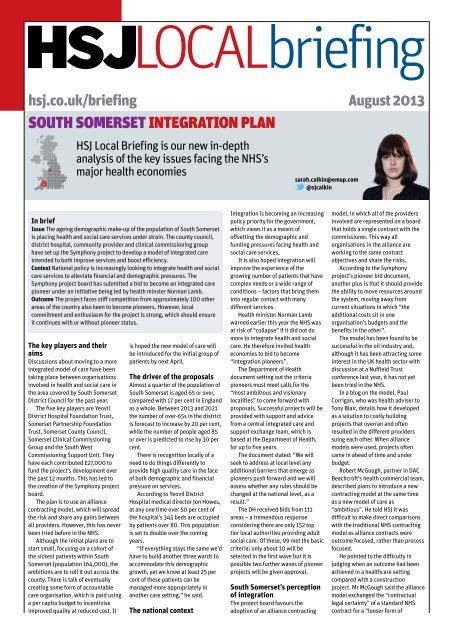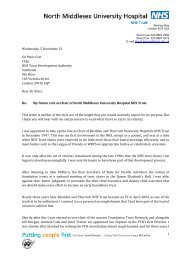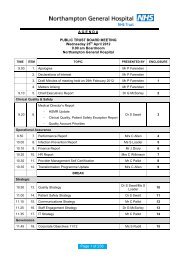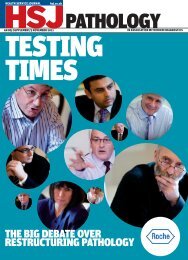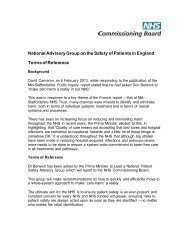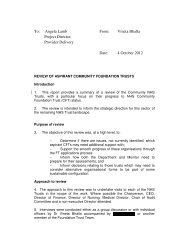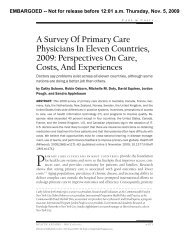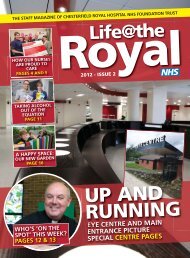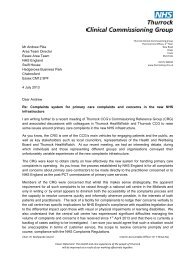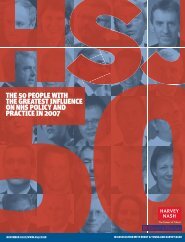South Somerset integration plan - Health Service Journal
South Somerset integration plan - Health Service Journal
South Somerset integration plan - Health Service Journal
You also want an ePaper? Increase the reach of your titles
YUMPU automatically turns print PDFs into web optimized ePapers that Google loves.
LOCALbriefinghsj.co.uk/briefing<strong>South</strong> <strong>Somerset</strong> <strong>integration</strong> <strong>plan</strong>HSJ Local Briefing is our new in-depthanalysis of the key issues facing the NHS’smajor health economiessarah.calkin@emap.com@sjcalkinAugust 2013In briefIssue The ageing demographic make-up of the population of <strong>South</strong> <strong>Somerset</strong>is placing health and social care services under strain. The county council,district hospital, community provider and clinical commissioning grouphave set up the Symphony project to develop a model of integrated careintended to both improve services and boost efficiency.Context National policy is increasingly looking to integrate health and socialcare services to alleviate financial and demographic pressures. TheSymphony project board has submitted a bid to become an integrated carepioneer under an initiative being led by health minster Norman Lamb.Outcome The project faces stiff competition from approximately 100 otherareas of the country also keen to become pioneers. However, localcommitment and enthusiasm for the project is strong, which should ensureit continues with or without pioneer status.The key players and theiraimsDiscussions about moving to a moreintegrated model of care have beentaking place between organisationsinvolved in health and social care inthe area covered by <strong>South</strong> <strong>Somerset</strong>District Council for the past year.The five key players are YeovilDistrict Hospital Foundation Trust,<strong>Somerset</strong> Partnership FoundationTrust, <strong>Somerset</strong> County Council,<strong>Somerset</strong> Clinical CommissioningGroup and the <strong>South</strong> WestCommissioning Support Unit. Theyhave each contributed £27,000 tofund the project’s development overthe past 12 months. This has led tothe creation of the Symphony projectboard.The <strong>plan</strong> is to use an alliancecontracting model, which will spreadthe risk and share any gains betweenall providers. However, this has neverbeen tried before in the NHS.Although the initial <strong>plan</strong>s are tostart small, focusing on a cohort ofthe sickest patients within <strong>South</strong><strong>Somerset</strong> (population 164,000), theambitions are to roll it out across thecounty. There is talk of eventuallycreating some form of accountablecare organisation, which is paid usinga per capita budget to incentiviseimproved quality at reduced cost. Itis hoped the new model of care willbe introduced for the initial group ofpatients by next April.The driver of the proposalsAlmost a quarter of the population of<strong>South</strong> <strong>Somerset</strong> is aged 65 or over,compared with 17 per cent in Englandas a whole. Between 2013 and 2021the number of over-65s in the districtis forecast to increase by 20 per cent,while the number of people aged 85or over is predicted to rise by 30 percent.There is recognition locally of aneed to do things differently toprovide high quality care in the faceof both demographic and financialpressure on services.According to Yeovil DistrictHospital medical director Jon Howes,at any one time over 50 per cent ofthe hospital’s 345 beds are occupiedby patients over 80. This populationis set to double over the comingyears.“If everything stays the same we’dhave to build another three wards toaccommodate this demographicgrowth, yet we know at least 25 percent of these patients can bemanaged more appropriately inanother care setting,” he said.The national contextIntegration is becoming an increasingpolicy priority for the government,which views it as a means ofoffsetting the demographic andfunding pressures facing health andsocial care services.It is also hoped <strong>integration</strong> willimprove the experience of thegrowing number of patients that havecomplex needs or a wide range ofconditions − factors that bring theminto regular contact with manydifferent services.<strong>Health</strong> minister Norman Lambwarned earlier this year the NHS wasat risk of “collapse” if it did not domore to integrate health and socialcare. He therefore invited healtheconomies to bid to become“<strong>integration</strong> pioneers”.The Department of <strong>Health</strong>document setting out the criteriapioneers must meet calls for the“most ambitious and visionarylocalities” to come forward withproposals. Successful projects will beprovided with support and advicefrom a central integrated care andsupport exchange team, which isbased at the Department of <strong>Health</strong>,for up to five years.The document stated: “We willseek to address at local level anyadditional barriers that emerge aspioneers push forward and we willassess whether any rules should bechanged at the national level, as aresult.”The DH received bids from 111areas − a tremendous responseconsidering there are only 152 toptier local authorities providing adultsocial care. Of these, 99 met the basiccriteria; only about 10 will beselected in the first wave but it ispossible two further waves of pioneerprojects will be given approval.<strong>South</strong> <strong>Somerset</strong>’s perceptionof <strong>integration</strong>The project board favours theadoption of an alliance contractingmodel, in which all of the providersinvolved are represented on a boardthat holds a single contract with thecommissioner. This way allorganisations in the alliance areworking to the same contractobjectives and share the risks.According to the Symphonyproject’s pioneer bid document,another plus is that it should providethe ability to move resources aroundthe system, moving away fromcurrent situations in which “theadditional costs sit in oneorganisation’s budgets and thebenefits in the other”.The model has been found to besuccessful in the oil industry and,although it has been attracting someinterest in the UK health sector withdiscussion at a Nuffield Trustconference last year, it has not yetbeen tried in the NHS.In a blog on the model, PaulCorrigan, who was health adviser toTony Blair, details how it developedas a solution to costly buildingprojects that overran and oftenresulted in the different providerssuing each other. When alliancemodels were used, projects oftencame in ahead of time and underbudget.Robert McGough, partner in DACBeachcroft’s health commercial team,described <strong>plan</strong>s to introduce a newcontracting model at the same timeas a new model of care as“ambitious”. He told HSJ it wasdifficult to make direct comparisonswith the traditional NHS contractingmodel as alliance contracts wereoutcome focused, rather than processfocused.He pointed to the difficulty injudging when an outcome had beenachieved in a healthcare settingcompared with a constructionproject. Mr McGough said the alliancemodel exchanged the “contractuallegal certainty” of a standard NHScontract for a “looser form of
LOCALbriefinghsj.co.uk/briefing<strong>South</strong> <strong>Somerset</strong> <strong>integration</strong> <strong>plan</strong>August 2013arrangement” based on “good faith,integrity” and the shared interest inachieving the commissionedoutcomes.“This would be a significant shiftin risk for a commissioner to acceptand would be outwith of the guidanceand structures which they arecurrently required to use,” he added.Jeremy Martin, project director atSymphony project, told HSJ theproject board had selected thealliance model − rather than otherarrangements that involve oneorganisation taking the lead − due toa desire to work together. He said:“We’ve got a good history of workingtogether in <strong>Somerset</strong>. There’s beenquite a lot of stability despite recentorganisational changes and quite alot of relationships that have built upover time that are still in place.”Selecting a cohort of patients whocould benefit most from integratedcareThe project board commissionedthe <strong>South</strong> West CommissioningSupport Unit and the Centre for<strong>Health</strong> Economics at the University ofYork to develop a database linkinganonymised patient level data formore than 109,000 patients acrossprimary, community, mental healthand social care.This included information on age,number of GP contacts, cost of acutecare at national tariff, average costper primary care encounter,community hospital bed days and thecosts of any social care. Data on otherkey services such as district nursingand end of life care is not yetavailable but hopefully will be nextyear.An analysis found the number ofconditions an individual had wasmore likely to lead to higher costs ofcare than age. In total 11.45 per centof the variation between money spenton individuals’ care was explained byhow many conditions individualshad. By comparison, just 3.35 percent of variation in costs could beattributed to age.Mr Martin said the large amount ofunaccounted for variation, whichcould be down to factors such ashome circumstances, made itimportant to get the size of the firstgroup of patients right. “The sharedbudget will have to have enoughpatients in it to cope with thevariation between patients, but wealso need to start with a small enoughgroup that we can realistically startworking in a new way over a shorttime period,” he said.The annual cost per patient for anindividual with seven or moreconditions, £10,741, is 13 times thatof a patient with just one disorder.The analysis found the majority of thedifference is driven by acuteinpatient costs. More details of thisanalysis can be found in the biddocument.Kevin Hudson, director of businesssolutions and innovation at the CSU,told HSJ the agreement of GPs toshare practice level data had helpedproduce a “much richer view of thepatient”. He said the data suggesteda need to take a more “holistic” lookat patient care, rather than focusingon disease specific approaches.“This is going to be invaluablewhen other CCGs come to look atcollaborative care and year of carebudgets,” he added.Andrew Street, professor of healtheconomics at York University, saidthe dataset was “up there with thebest” due to the linking of activityand cost data across health and socialcare organisations and the ability tolook at the combination of conditionspatients have.The university is to host someworkshops with health and socialcare staff in <strong>South</strong> <strong>Somerset</strong> inSeptember to agree which groups ofpatients should be targeted.Professor Street said: “Gettingpeople together to talk about thingsand share experiences andunderstand the nature and pattern ofcare in the area will provideownership and ideas of how thesemodels might be rearranged for thebenefit of the local population.”Based on the data available, it wasfound that 2 per cent of thepopulation accounted for £17m of the£100m costs across the healthcommunity. Dr Howes said: “Thesepatients could be taken out of thecurrent model of managing themthrough primary care and managedthrough some sort of network thatintegrates all the teams at communityhospitals and possibly Yeovil DistrictHospital.”A new financial modelThe ambition is to develop a “year ofcare” style weighted per capitabudget for the patients in the firstcohort. Decisions are still to be madeabout how this would work inpractice and how the money wouldmove between organisations. MrMartin acknowledged it will be“complicated” to negotiate thebudget to the satisfaction of allparties.Mr McGough, of DAC Beachcroft,said the normal method for analliance contract would seeparticipants paid for certain agreedcosts incurred in delivering theservice. A risk and reward regimewould then incentivise improvedperformance against the outcomes inthe contract.He added: “Clearly, in order toimplement an alliance contractmodel, then the finance andremuneration mechanism needs to beconsidered in detail to ensure thereare no perverse results (excessiverewards or penalties imposed uponthe parties) and that it is possible toutilise the alternative financialstructure under the terms of NHSfinancing such as payment byresults.”Likelihood of successThere is a clear commitment from allpartners to press ahead with theproject, whether it gains pioneerstatus or not. However, the additionalDH support that pioneer status wouldbring would undoubtedly provevaluable. Mr Martin sees the biggestadvantage as the “support andexpertise” to help the project throughsome of the contracting and financialissues.At first glance the project meetskey criteria set out by the DH. Thisstates they must have a clear vision,involve <strong>plan</strong>ning for whole system<strong>integration</strong>, have support from acrossthe community and commit tosharing lessons across the system.Support across <strong>Somerset</strong> appearsto be strong with organisationsincluding: local housing association,Yarlington Housing Group; YeovilCollege; and local charities <strong>South</strong><strong>Somerset</strong> Mind and Age UK <strong>Somerset</strong>backing the project.More than 60 staff from variouslevels of the different partners havebeen involved in discussions abouthow to integrate services while aseparate event brought together 30local GPs and consultants to discussthe <strong>plan</strong>s.<strong>Somerset</strong> local medical committeechair Sue Roberts told HSJ there wasa lot of enthusiasm for the project.“Most of the Yeovil GPs are involvedin the project and they all buy into it.It’s a new and exciting way forward,”she said.Areas are also required to showthey have the capability andexpertise to deliver public sectorchange at “scale and at pace”. Twomembers of the project board weremembers of the senior leadershipteam at Torbay Care Trust, which hasled the way in the development ofintegrated community health andsocial care in England.Yeovil District Hospital Trust chiefexecutive Paul Mears was director of
LOCALbriefinghsj.co.uk/briefing August 2013<strong>South</strong> <strong>Somerset</strong> <strong>integration</strong> <strong>plan</strong>operations at the trust for four yearswhile Bristol, North <strong>Somerset</strong>,<strong>Somerset</strong> and <strong>South</strong> Gloucestershirelocal area team director AnthonyFarnsworth spent six years at directorlevel at the trust, including two and ahalf years as chief executive.<strong>Somerset</strong> Partnership has form onthe issue after integrating mentalhealth and community services overthe past two years. The organisationhas also recently worked with thecounty council and private sectorsocial care providers to set upindependent living teams focusing onthe reablement of patients.In terms of the requirement todemonstrate the approach is basedon a “robust understanding of thedata”, the York University analysishas reportedly been described byacademics there as one of the“richest” datasets of its kind.The project also has influentialsupport in the form of Yeovil MP andschools minister David Laws.However, the large number of bidsmeans only one in every 10 has achance of success and thecompetition includes many moreestablished <strong>integration</strong> projects,most notably Torbay. With odds likethat the Symphony project is far froma shoo-in.The challenge of implementing analliance contract should not beunderestimated, with or withoutpioneer status. The rhetoric from thegovernment surrounding the<strong>integration</strong> pioneers is radical −pioneers will be expected to havetested new reimbursement models.However, there is scepticism abouthow much freedom pioneers willactually be allowed.The criteria document suggeststhere will not be scope for ignoringcurrent choice and competitionlegislation but merely for“clarification of rules and howintegrated solutions can comply withthem”.The level of enthusiasm among thevarious partners, particularly GPs,bodes well for the continuation of theproject regardless. However, most ofthe toughest conversations abouthow the money and risk is sharedbetween providers are still to be had.The combination of the nationalpolicy focus on <strong>integration</strong> and stronglocal commitment to improvingpatient experience should ensureprogress on the Symphony projectbut the partners may need to beflexible about what form that takes.


